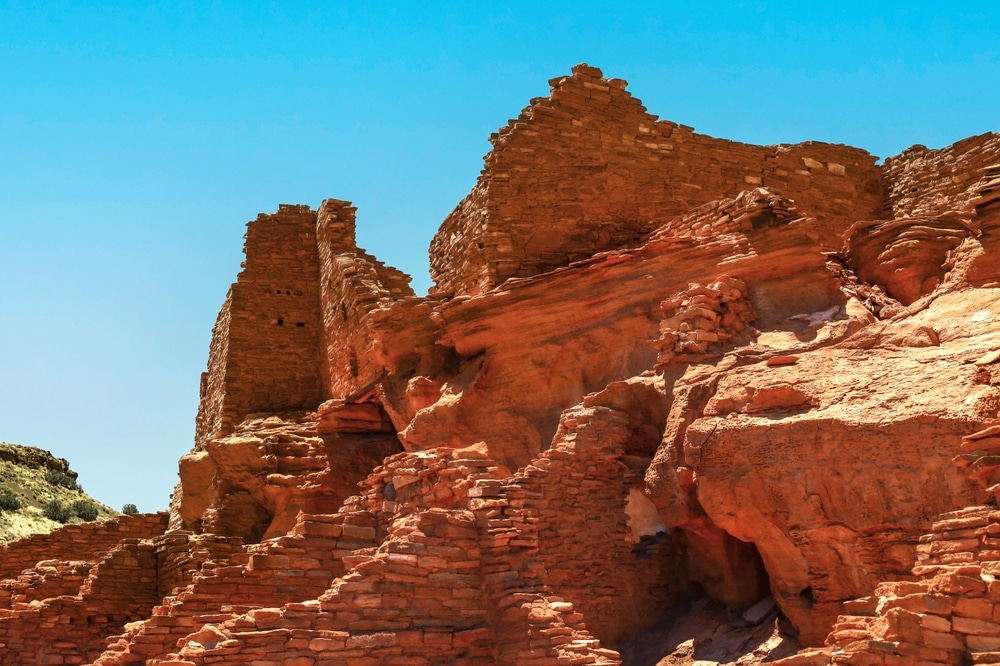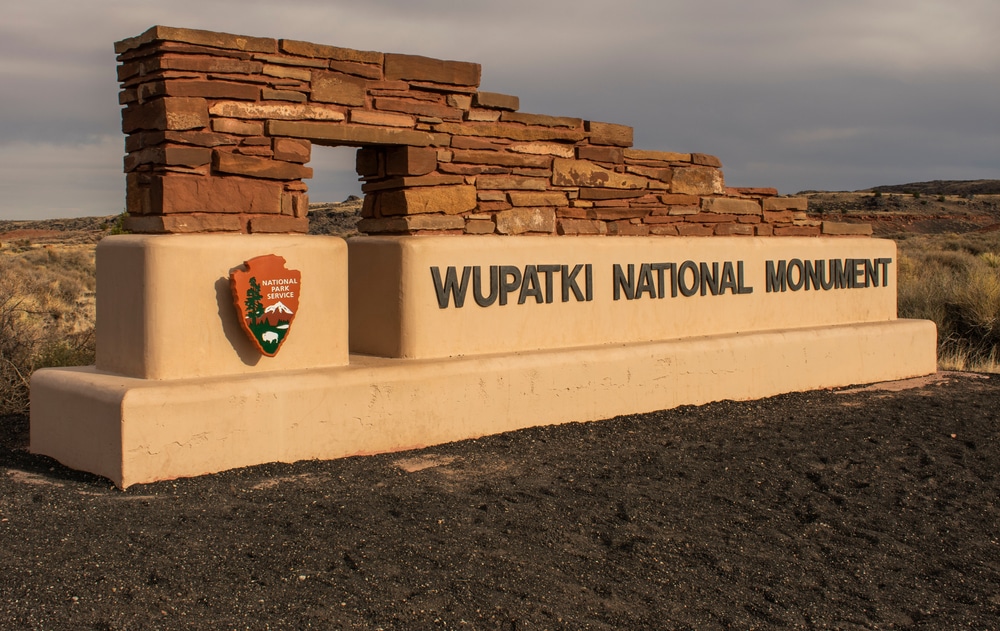Rising from the red-rock landscape of northern Arizona, Wupatki National Monument preserves one of the most remarkable concentrations of ancient pueblos in the American Southwest. Situated between the painted deserts of the Navajo Nation and the pine forests of the San Francisco Peaks, this 35,422-acre monument protects more than 2,700 archaeological sites, including several major pueblo complexes built by indigenous peoples nearly a millennium ago.
Wupatki, meaning “Tall House” in the Hopi language, stands as a testament to human resilience and adaptation in an environment that appears, at first glance, too harsh to support large settlements. Yet, during the 1100s CE, thousands of people lived, farmed, traded, and thrived in this arid landscape, creating communities that served as cultural crossroads where different traditions and peoples converged and interacted.
The monument’s signature structures—massive multistory pueblos built from red sandstone—stand in striking contrast against the expansive desert backdrop, their walls still bearing witness to the ingenuity and architectural skill of their builders. These ancient dwellings, along with ball courts, amphitheaters, and other community structures, provide insights into a complex society that developed sophisticated agricultural techniques, far-reaching trade networks, and rich cultural traditions.
Established in 1924 by President Calvin Coolidge, Wupatki National Monument now offers visitors an opportunity to explore this fascinating chapter of American history while experiencing the austere beauty of the high desert. Located just 30 miles northeast of Flagstaff, the monument provides accessible yet profound encounters with both cultural heritage and natural wonders, including unusual geological features formed by ancient volcanic activity in the region.

The centerpiece of the monument, the Wupatki Pueblo, is a large multi-story dwelling built by the Ancestral Puebloans over 800 years ago. The pueblo features more than 100 rooms, a community room, and even a ball court. Take a self-guided tour along the paved path to learn about the history and ingenuity of the people who lived here.
These smaller yet equally impressive pueblos offer insight into the lives of ancient Native American communities. The Citadel Pueblo, perched atop a hill, provides stunning panoramic views of the surrounding Painted Desert and volcanic fields. The Nalakihu Pueblo, located nearby, is another great stop showcasing the area’s architectural heritage.
Wupatki National Monument is located near Sunset Crater Volcano National Monument, making it easy to combine the two destinations. The volcanic activity from Sunset Crater around 1085 AD played a crucial role in shaping the landscape and providing fertile soil, which supported agriculture for the ancient inhabitants.

Wupatki National Monument offers several short and accessible hiking trails that lead to archaeological sites and scenic vistas. The trails are ideal for exploring the desert environment, unique rock formations, and historic ruins. Don’t forget to bring water and sunscreen, as the area can get quite hot.

Start your visit at the Wupatki Visitor Center to gain a deeper understanding of the monument’s history, geology, and cultural significance. The center features exhibits on Native American life, the region’s volcanic history, and the unique ecosystem of the desert.

Check the schedule for ranger-led programs, which provide in-depth knowledge about the monument’s history, geology, and wildlife. These programs often include guided hikes, night sky viewing events, and discussions on the cultural significance of the area.

Near the Wupatki Pueblo, you’ll find a unique geological feature called the blowhole, a natural vent in the earth that releases air due to underground pressure changes. Also nearby is a reconstructed ball court, which highlights the cultural connections between the Ancestral Puebloans and their Mesoamerican neighbors.

Despite its desert environment, Wupatki is home to a variety of wildlife, including pronghorn antelope, jackrabbits, and birds of prey. Bring binoculars to spot animals and appreciate the biodiversity of this arid landscape.
Wupatki National Monument is part of a designated International Dark Sky Park, making it an exceptional spot for stargazing. On clear nights, visitors can witness a brilliant display of stars, planets, and even the Milky Way galaxy.

The Loop Road connecting Wupatki and Sunset Crater Volcano National Monuments offers a scenic drive through striking desert and volcanic landscapes. This 35-mile route is a great way to soak in the natural beauty of the area.

| Category | Details |
|---|---|
| Location | Northern Arizona, USA |
| Established | December 9, 1924 |
| Managed By | National Park Service |
| Size | Approximately 35,422 acres (14,338 hectares) |
| Main Attractions | Wupatki Pueblo, Citadel Pueblo, Lomaki Pueblo, Box Canyon Dwellings |
| Cultural Significance | Historic site featuring ancient pueblo ruins built by the Ancestral Puebloans. |
| Time Period | Ruins date from approximately 500 to 1225 CE |
| Geology | Located on the Colorado Plateau; features volcanic activity remnants |
| Ecosystem | Semi-arid desert, characterized by sparse vegetation and unique wildlife |
| Nearby Landmarks | Sunset Crater Volcano National Monument (approx. 18 miles away) |
| Visitor Activities | Hiking, photography, ranger programs, cultural demonstrations |
| Climate | Hot summers, cool winters, and limited rainfall |
| Entrance Fee | $25 per vehicle (valid for 7 days, subject to change) |
| Accessibility | Visitor center and some trails are wheelchair accessible |
| Fun Fact | “Wupatki” means “Tall House” in the Hopi language. |
The story of Wupatki begins with a cataclysmic event that transformed the region’s natural and human landscape. Around 1064 CE, nearby Sunset Crater erupted, covering over 800 square miles with volcanic ash and cinders. While initially devastating, this eruption ultimately created conditions that improved agricultural potential by helping the soil retain moisture—a precious commodity in this arid environment.
In the decades following the eruption, people began moving into the Wupatki area in unprecedented numbers. Archaeological evidence suggests that the population surged between 1100 and 1250 CE, with thousands of people inhabiting the region. These settlers, whom archaeologists identify as Ancestral Puebloans (previously called Anasazi) and Sinagua peoples, constructed hundreds of settlements ranging from small single-family dwellings to large multi-room pueblos that housed numerous families.
The largest structure, Wupatki Pueblo itself, ultimately grew to over 100 rooms and stood multiple stories tall, housing perhaps 85-100 people and serving as a community center for the surrounding area. Built with thin slabs of the local Moenkopi sandstone expertly fitted without mortar in many sections, the pueblo showcases sophisticated architectural knowledge that included support beams, T-shaped doorways, and strategic room placement for thermal regulation.
Other major pueblos within the monument include:
Wukoki Pueblo: A striking three-story structure perched atop a rock outcropping, offering commanding views of the surrounding landscape
Lomaki Pueblo: Built along the edge of a small canyon, featuring about 20 rooms
Citadel Pueblo: Situated atop a mesa with panoramic views, this defensive structure controlled access to the surrounding area
Nalakihu Pueblo: A small pueblo near the Citadel, containing approximately 6-8 rooms
These structures weren’t built in isolation but formed part of an interconnected regional community. Archaeological evidence indicates regular communication, trade, and likely intermarriage between different settlements, creating a complex social network across the landscape.
What makes Wupatki particularly significant to archaeologists and historians is its role as a cultural crossroads where different indigenous traditions met and mingled. The monument preserves evidence of interaction between at least four major cultural traditions: Ancestral Puebloan, Cohonina, Sinagua, and Kayenta.
This cultural blending is visible in the architecture and artifacts found at Wupatki. The pueblos incorporate building techniques from different traditions, while artifacts include pottery styles from various regions, including distinctive Hohokam red-on-buff ware from southern Arizona, Kayenta black-on-white pottery from northeastern Arizona, and locally produced Alameda Brown Ware.
Perhaps the most striking evidence of cultural interaction is the Wupatki ball court—one of the northernmost examples of this Mesoamerican cultural feature. The oval-shaped depression measures approximately 102 feet long by 64 feet wide and bears remarkable similarity to ball courts found throughout ancient Mexico and Central America, suggesting long-distance cultural connections or trade relationships extending far to the south.
Adjacent to Wupatki Pueblo stands another unique feature—a circular masonry structure identified as a community amphitheater, which could have accommodated about 50 people for ceremonies or meetings. Such communal spaces highlight the social organization and shared cultural activities that bound these communities together.
The legacy of Wupatki continues through the cultural traditions of several modern Native American tribes who maintain spiritual and ancestral connections to these ancient dwellings. The Hopi, who refer to the area as Wupat’nga, consider the residents of Wupatki to be among their ancestors. Hopi clan histories include references to migrations through the Wupatki region, and some clans trace specific lineages to these settlements.
Other tribes with historical and cultural connections to Wupatki include the Zuni, Navajo, and several bands of the Southern Paiute. For many indigenous people, these archaeological sites are not merely abandoned ruins but ancestral homes imbued with ongoing spiritual significance.
The National Park Service works collaboratively with affiliated tribes through consultation on management decisions, interpretation of cultural resources, and special access for traditional ceremonies and practices. This partnership acknowledges the living cultural heritage that connects past and present at Wupatki.
By the mid-13th century, the dense population that once inhabited the Wupatki region began to decline, and by approximately 1275 CE, most of the pueblos had been permanently abandoned. The reasons for this exodus remain a subject of scholarly debate, but several factors likely contributed:
Archaeological evidence suggests that the abandonment was planned rather than precipitous. Residents appear to have taken most of their possessions with them, sealed some rooms, and ceremonially “closed” certain spaces—indicating an organized departure rather than a crisis-driven flight.
The descendants of Wupatki’s inhabitants carried their cultural knowledge, religious practices, and social traditions to new communities, where aspects of their heritage continue to be preserved in the practices and oral histories of modern Pueblo peoples.
Wupatki National Monument occupies a transitional zone between distinct ecological regions in northern Arizona. Situated at elevations ranging from approximately 4,900 to 6,700 feet above sea level, the monument spans the boundary between the higher-elevation pine forests associated with the San Francisco Peaks to the southwest and the lower-elevation painted deserts extending to the northeast.
The landscape is characterized by wide, open expanses punctuated by mesas, buttes, and shallow canyons. The dominant colors are the rusty reds of the Moenkopi sandstone formations and the black of basaltic rocks from prehistoric lava flows, creating a visually striking landscape under the brilliant blue Arizona sky.
Wupatki experiences a semi-arid climate typical of the high desert, with four distinct seasons:
Spring (March-May): Mild days and cool nights with occasional strong winds; wildflowers may bloom after winter moisture
Summer (June-September): Hot days regularly exceeding 90°F, with brief but intense monsoon thunderstorms typically arriving in July and August
Autumn (September-November): Gradually cooling temperatures with clear, stable weather patterns and excellent visibility
Winter (December-February): Cold conditions with occasional snow, particularly at higher elevations within the monument
Annual precipitation averages just 8-10 inches, with much of it coming during the summer monsoon season and winter snowfall. This limited moisture, combined with rapid evaporation rates and porous soils, creates challenging conditions for plant and animal life—and made the agricultural achievements of the ancient inhabitants all the more remarkable.
The geological story of Wupatki begins millions of years ago with the deposition of the Moenkopi Formation—the distinctive red sandstone and siltstone that provided building material for the ancient pueblos. These sedimentary rocks, formed approximately 240 million years ago during the early Triassic period, represent ancient tidal flats and shallow marine environments that once covered this region.
The more recent and dramatic chapter in Wupatki’s geological history involves volcanic activity associated with the San Francisco Volcanic Field to the southwest. The eruption of Sunset Crater Volcano around 1064 CE profoundly transformed the landscape, depositing a layer of black cinders and ash across the region that is still visible today as a dark soil component.
Several unusual geological features within the monument resulted from this volcanic activity:
Wupatki Blowhole: Near the main pueblo, a small opening in the earth connects to an underground fracture system that either expels or draws in air, depending on atmospheric pressure changes. On days when air is flowing outward, the blowhole can produce a noticeable breeze that was likely known to the ancient inhabitants.
Lava Flows: Although the main lava flows from Sunset Crater didn’t reach what is now Wupatki National Monument, scattered basaltic rocks throughout the landscape were transported here by earlier volcanic events.
Cinder Fields: Areas where black volcanic cinders blanket the red sandstone create unusual and photogenic landscapes, particularly along the boundary with neighboring Sunset Crater Volcano National Monument.
The geological diversity of Wupatki contributes to both its scenic beauty and its archaeological significance, as the ancient inhabitants skillfully utilized different stone types for various construction purposes.
Despite its arid appearance, Wupatki supports a surprisingly diverse biological community adapted to desert conditions. The monument encompasses several ecological zones, each with characteristic plant and animal assemblages:
The monument’s wildlife includes:
Mammals: Pronghorn antelope, mule deer, coyotes, kit foxes, bobcats, jackrabbits, and various rodent species
Birds: Over 160 species have been recorded, including golden eagles, red-tailed hawks, American kestrels, ravens, pinyon jays, and numerous songbirds
Reptiles: Several lizard species including collared lizards, side-blotched lizards, and horned lizards; snake species include gopher snakes and occasionally rattlesnakes
While wildlife may not always be readily visible to visitors, especially during daytime summer heat, their tracks and signs can be observed by careful observers throughout the monument. Dawn and dusk offer the best wildlife viewing opportunities, when many desert animals are most active.
Wupatki National Monument offers visitors several impressive archaeological sites connected by a scenic loop road. The primary attractions include:
Each of these sites offers unique perspectives on ancient Puebloan architecture and adaptation to the environment. Most visitors can see the major sites in 2-3 hours, though a half-day visit allows for a more thorough exploration and appreciation of the monument.
The Wupatki Visitor Center serves as the starting point for most monument visits. Located near Wupatki Pueblo, the visitor center offers:
Educational programs available at the monument include:
Ranger-led Talks: Scheduled presentations at Wupatki Pueblo covering various aspects of the monument’s cultural and natural history
Junior Ranger Program: Activity booklets for children that encourage exploration and learning throughout the monument
Cultural Demonstrations: Occasional programs featuring traditional skills and crafts from affiliated Native American tribes
Night Sky Programs: Seasonal astronomy events taking advantage of the monument’s dark skies
School Group Programs: Educational activities aligned with curriculum standards for visiting school groups (advance reservation required)
For those seeking in-depth information, the visitor center provides a bibliography of scholarly and popular books about Wupatki and related archaeological sites in the region.
While the primary focus of Wupatki National Monument is cultural heritage, the landscape also offers several recreational opportunities:
The National Park Service has worked to make Wupatki reasonably accessible to visitors with disabilities, though the remote location and preservation requirements create some limitations:
Wupatki National Monument is located approximately 30 miles northeast of Flagstaff, Arizona, making it accessible as a day trip from this gateway city:
Most visitors approach Wupatki by first passing through Sunset Crater Volcano National Monument, creating a natural progression from the volcanic landscape that triggered settlement to the ancient communities that developed in its aftermath. However, the loop road can be driven in either direction.
Wupatki National Monument is open year-round, with each season offering different advantages and considerations:
The monument experiences its highest visitation during spring break periods, summer vacation season, and weekends throughout the year. For a more solitary experience, consider visiting on weekdays, particularly during the winter months when few tourists venture to the monument.
No lodging or camping facilities exist within Wupatki National Monument, but several options are available in the vicinity:
Flagstaff (30 miles): Full range of accommodation options from budget motels to upscale hotels
Cameron (25 miles north): Cameron Trading Post offers motel rooms and a restaurant
Grand Canyon (approximately 60 miles northwest): Various lodging options both inside and outside the national park
Bonito Campground: Located in nearby Sunset Crater Volcano National Monument, this first-come, first-served U.S. Forest Service campground offers 44 sites (closed in winter)
Coconino National Forest: Dispersed camping is permitted in designated areas
Commercial RV parks and campgrounds in and around Flagstaff
Many visitors choose to pack a picnic lunch to enjoy at the designated picnic areas within the monument, allowing for a more immersive experience without having to leave for meals.
Archaeological investigation at Wupatki began in the early 20th century and continues today, though with significantly different approaches and ethics. Early excavations focused primarily on recovering artifacts and understanding architectural features, while modern research emphasizes minimal disturbance, non-invasive techniques, and collaboration with affiliated tribes.
Current preservation efforts include:
Structural Stabilization: Careful monitoring and maintenance of pueblo walls and features to prevent deterioration while maintaining archaeological integrity
Documentation: Comprehensive mapping, photography, and 3D scanning to record site conditions and track changes over time
Scientific Research: Ongoing studies using techniques like ground-penetrating radar, dendrochronology (tree-ring dating), and archaeoastronomy to better understand the sites without excavation
Materials Conservation: Specialized treatment and storage of artifacts recovered from earlier excavations to ensure their long-term preservation
Climate Change Monitoring: Tracking how changing precipitation patterns and temperature regimes affect archaeological resources
The National Park Service employs professional archaeologists and partners with academic institutions to conduct research that informs management decisions and enhances visitor understanding while minimizing impacts on the fragile resources.
A fundamental aspect of Wupatki’s management is recognition that these ancient structures are not simply archaeological sites but ancestral homes with ongoing cultural significance to multiple Native American communities. The National Park Service maintains government-to-government relationships with several affiliated tribes, including:
Collaborative initiatives include:
Consultation on Management Decisions: Tribal representatives provide input on how sites are preserved, interpreted, and presented to the public
Traditional Cultural Knowledge: Incorporation of indigenous perspectives and knowledge into monument interpretation
Youth Programs: Opportunities for Native American youth to connect with ancestral sites and learn both scientific and traditional approaches to cultural preservation
Special Access: Arrangements for tribal members to conduct traditional practices and ceremonies at the monument
Language Preservation: Inclusion of indigenous place names and terminology in monument materials
These partnerships acknowledge that cultural heritage extends beyond physical structures to encompass living traditions, language, spirituality, and identity that continue to be shaped by connections to ancestral places.
As with many cultural sites, Wupatki faces the challenge of balancing public access with resource protection. Several measures help manage visitor impact:
Tourists can contribute to preservation efforts by:
Beyond cultural resource management, Wupatki National Monument faces several environmental challenges:
Climate Change: Increasing temperatures and changing precipitation patterns affect both natural ecosystems and archaeological structures
Invasive Species: Non-native plants like cheatgrass and Russian thistle threaten to displace native vegetation and alter fire regimes
Water Resource Management: Ensuring sustainable water supplies for monument operations while protecting natural seeps and springs
Viewshed Protection: Preserving the undeveloped landscape surrounding the monument from encroaching development
Air Quality: Monitoring impacts from regional power plants, vehicle emissions, and occasional wildfire smoke
The National Park Service addresses these challenges through scientific monitoring, habitat restoration projects, sustainable operations practices, and collaboration with neighboring land management agencies to develop landscape-scale approaches to environmental stewardship.
Wupatki National Monument preserves a remarkable chapter in North America’s cultural heritage—a story of human adaptation, creativity, and resilience in a challenging environment. The monument’s ancient pueblos stand as testament to the sophisticated knowledge and social organization of those who built them, while also connecting present-day visitors to enduring indigenous traditions that continue to draw meaning and inspiration from these ancestral places.
As you walk among these structures, you enter a landscape where past and present converge. The same red cliffs and distant mountain vistas that framed daily life for the ancient inhabitants now form the backdrop for your own experience. The handprints of long-ago builders remain visible in meticulously laid stone walls. Doorways that once welcomed family members now frame views for modern photographs. These tangible connections across time provide one of Wupatki’s most profound gifts—an opportunity to reflect on both the distinctiveness of ancient lifeways and the commonalities of human experience across the centuries.
Unlike many archaeological sites worldwide, Wupatki benefits from its connection to living indigenous cultures whose members maintain spiritual and historical ties to these places. Their perspectives enrich our understanding of the monument, reminding us that these are not merely abandoned ruins but ancestral homes imbued with ongoing cultural significance. This continuity of cultural knowledge adds depth and dimension to the visitor experience while ensuring that management decisions respect indigenous values and traditions.
For today’s visitors, Wupatki offers multiple rewards: the intellectual stimulation of learning about ancient cultures; the aesthetic pleasure of remarkable architecture set against stunning natural backdrops; the sensory experience of desert light, sound, and space; and the contemplative opportunity to connect with both past and present in a landscape that has witnessed centuries of human history. Whether you spend a few hours exploring the main pueblo or a full day investigating the monument’s various sites, Wupatki provides an accessible yet profound encounter with the rich cultural heritage of the American Southwest.
As we face contemporary challenges of environmental change and cultural preservation, Wupatki also offers valuable lessons in adaptation and sustainability. The ancient inhabitants developed innovative techniques for desert agriculture, established wide-reaching trade networks, and created communities that integrated diverse cultural traditions—accomplishments that resonate with modern concerns about resource management, economic systems, and multicultural societies. In this sense, Wupatki serves not only as a window into the past but also as a source of perspective on present-day challenges.
By visiting with respect and curiosity, today’s travelers become part of the ongoing story of this remarkable place—a story that spans a thousand years of human relationship with the red rock landscape of northern Arizona. Through careful stewardship and thoughtful interpretation, Wupatki National Monument ensures that this story continues to inspire and educate generations to come.
Official Website: National Park Service – Wupatki National Monument
nps.gov/wupa
Visitor Information:
Wupatki National Monument
25137 N. Wupatki Loop Road
Flagstaff, AZ 86004
Phone: (928) 679-2365
Western National Parks Association: Operates bookstore and supports educational initiatives
Friends of Flagstaff National Monuments: Volunteer organization supporting Wupatki, Sunset Crater Volcano, and Walnut Canyon National Monuments